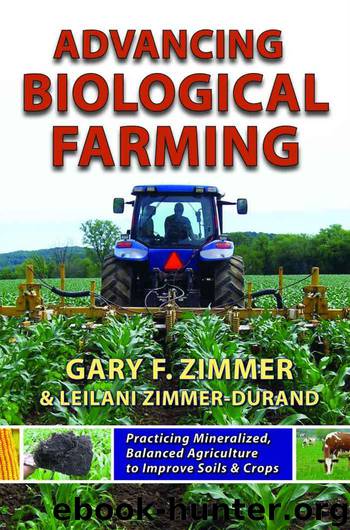Advancing Biological Farming: Practicing Mineralized, Balanced Agriculture to Improve Soil & Crops by Gary Zimmer & Leilani Zimmer-Durand

Author:Gary Zimmer & Leilani Zimmer-Durand [Zimmer, Gary]
Language: eng
Format: epub
ISBN: 9781601730527
Publisher: Acres U.S.A.
Published: 2015-01-22T05:00:00+00:00
How Much Fertilizer to Use
How much fertilizer to apply depends on the condition of your soils, the crop you are growing, and your budget.
The first time I travelled to Western Australia I got a real education on different approaches to farming. It is very dry there. They only get about 10 to 12 inches of rainfall a year. I met with wheat farmers who wanted to improve the fertility of their land, but the problem was it is so dry that their yields are only about 20 bushels per acre. With wheat selling at $3/ bushel, that does not leave much for a fertilizer budget. From their $60 per acre income they had to buy seed, plant the wheat, harvest the wheat, and make land payments. How could they do it? The answer is they don’t grow wheat every year; they also raise sheep on those same fields. They plant wheat and let their sheep graze it the first year and second spring, and then in late summer they pull the animals out, let the wheat plants go to seed, and then harvest the wheat. It isn’t possible for them to make any money just growing wheat, but by only planting once for both the sheep to graze and for wheat to harvest, they can make a little money off their land.
But what about their fertilizer budget? They have heavy soils that needed minerals. So I asked them, “If you only make $60/acre, what can you afford to spend on fertilizer?” “Well,” they said, “we can give you about three dollars an acre.” Were they going to bulk spread that three dollars worth of fertilizer? I told them if they were going to bulk spread it, we might as well go to the bar and have a beer and at least get something for the three dollars. Then we can go out to the field later and water something. We’ll at least get a few plants started that way!
What the Western Australian wheat farmers did in the end was to put whatever they bought directly on the seed, focusing their fertilizer right on the germinating plant. They applied some natural nitrogen-producing organisms, a root stimulant and trace minerals, and saw a great response from a budget of just a couple of dollars an acre. The seed treatment doubled roots and cut water needs. The farmers were ecstatic over the response they saw.
Download
This site does not store any files on its server. We only index and link to content provided by other sites. Please contact the content providers to delete copyright contents if any and email us, we'll remove relevant links or contents immediately.
Craft Beer for the Homebrewer by Michael Agnew(18140)
Marijuana Grower's Handbook by Ed Rosenthal(3622)
Barkskins by Annie Proulx(3312)
Project Animal Farm: An Accidental Journey into the Secret World of Farming and the Truth About Our Food by Sonia Faruqi(3177)
The Plant Messiah by Carlos Magdalena(2883)
Red Famine: Stalin's War on Ukraine by Anne Applebaum(2873)
0041152001443424520 .pdf by Unknown(2784)
Organic Mushroom Farming and Mycoremediation by Tradd Cotter(2626)
In the Woods by Tana French(2533)
Beer is proof God loves us by Charles W. Bamforth(2370)
7-14 Days by Noah Waters(2361)
Reservoir 13 by Jon McGregor(2242)
Borders by unknow(2227)
Meathooked by Marta Zaraska(2220)
The Art of Making Gelato by Morgan Morano(2216)
Birds, Beasts and Relatives by Gerald Durrell(2176)
Between Two Fires by Christopher Buehlman(2164)
The 7 Habits of Highly Effective People: Powerful Lessons in Personal Change (25th Anniversary Edition) by Covey Stephen R(2139)
The Lean Farm Guide to Growing Vegetables: More In-Depth Lean Techniques for Efficient Organic Production by Ben Hartman(2096)
